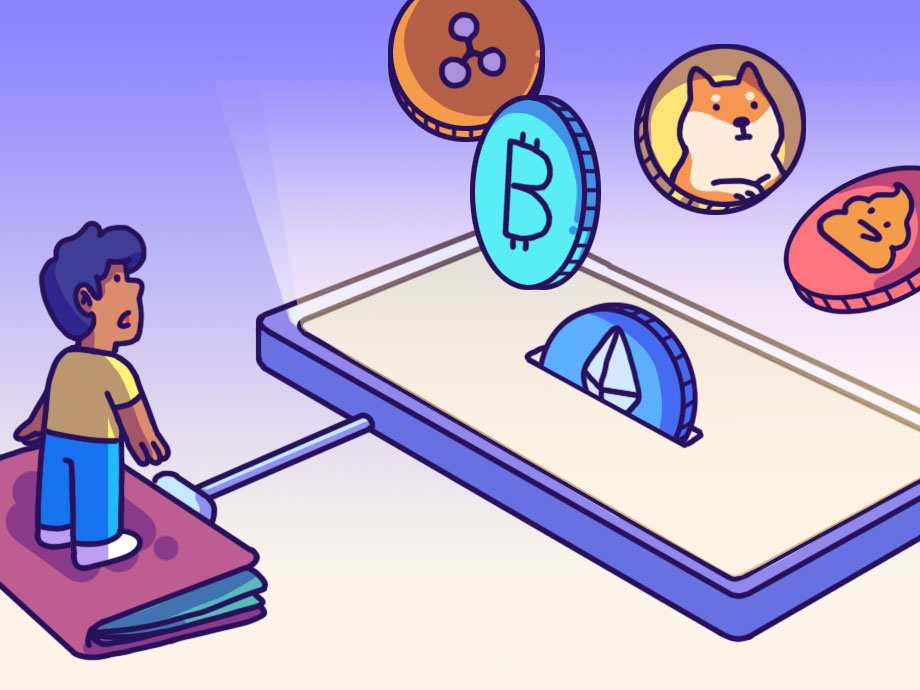Web3 | Article
Financial Services on Web3: Decentralised Finance (DeFi)
by The Simple Sum Team | 23 Sep 2022 | 5 mins read

As with cryptocurrencies, DeFi is built on the blockchain – the decentralised, immutable, public ledger that enables all computers on a network to hold a copy of a history of transactions. The idea is that no single entity has control over – or can alter – the ledger.
What makes DeFi distinct from cryptocurrencies like Bitcoin is that it expands the use of the blockchain from direct value transfers to more complex financial use cases. While bitcoin can only be used as a store of value, DeFi – powered by decentralised applications (dApps) – allow parties to exchange, lend, borrow, and trade directly using the blockchain without any intermediaries and costs.
At the core of DeFi are smart contracts, which is computer code that acts as a digital agreement between two parties. Running on the blockchain, smart contracts automatically execute transactions if certain conditions are met, and can be used for a variety of financial protocols like issuing crypto-backed loans and paying out interest on holdings.
Smart contracts are the fuel that powers DeFi and its protocols like Aave, Compound, and hundreds of others. Because they are processed on the blockchain, smart contracts can be sent automatically without a third party involved.
Most DeFi projects are built on top of Ethereum – the second largest cryptocurrency platform – because its programming languages are specifically designed for creating and deploying flexible smart contracts. They have since expanded to other networks that use smart contracts as well. These include Solana and Avalanche.
Anyone can use DeFi products by going to an application’s website and connecting with a DeFi-enabled crypto wallet (such as MetaMask on Ethereum, or Phantom on Solana).
Because the apps are built on the blockchain, users must then use that blockchain’s tokens to transact. For example, Ether is required to pay for transactions on the Ethereum network and SOL is necessary on the Solana network.
What Makes DeFi Unique?
There are several features that make DeFi radically different from the current financial system.
For one, it is completely open. This means that you can use the applications by creating a digital wallet rather than requiring the possession of a bank account.
Secondly, you can move funds around in almost an instant via the blockchain – reducing waiting times for bank transfer to clear.
Thirdly, the rates – at least for now – are much more competitive than traditional banks, although transaction costs vary depending on the blockchain network used. For example, Ethereum tends to have higher fees than other blockchains.
Uses of DeFi
1. Lending and borrowing
DeFi allows people on the internet to earn money in similar fashion to bankers – by earning fees on financial services. In most cases, this is done by providing liquidity, where investors “stake” digital currencies. The only difference being that they are lending digital currencies to apps rather than to people or companies.
You can lend cryptocurrencies to a protocol in exchange for interest and/or rewards. Similarly, you can borrow digital assets from protocols to make a trade.
Most DeFi protocols use over-collateralisation. This means that you must put up more than the amount you want to borrow. Hence, if the asset’s value plummets, the protocol may take your collateral to avoid losses.
Many advanced DeFi users utilise an investment strategy called “yield farming” – a risky practice which involves lending and staking cryptocurrency tokens to gain rewards in the form of interest. This is similar to earning interest from a bank account, only you’re technically lending money to a bank.
2. Trading
Whilst centralised exchanges like Coinbase and Binance take custody of your assets when trading, a decentralised exchange (DEX) removes that intermediary so that direct peer-to-peer trading can take place. Popular DEXs like Uniswap and PancakeSwap allow users to list new tokens for trading, as well as swap tokens for one another. For example, on Uniswap, a user can swap Ether for USD Coin.
DEXs work better the more liquidity they have on hand, hence they compete as much on providing attractive deals for liquidity providers as they do on being affordable for traders.
3. Derivatives
As with regular finance, derivatives are an essential element of any capital market, and DeFi is no exception. Compared to lending and trading, the DeFi derivatives space is still in its infancy. While derivatives are highly regulated in the real world, DeFi derivatives can be created by almost anyone in an open and permissionless way.
Synthetix is the most popular derivative protocol in DeFi at the moment, allowing for the creation of synthetic assets that track the value of a range of tradeable things. The protocol currently supports synthetic fiat currencies and commodities.
The role of stablecoins in DeFi
Because cryptocurrencies are volatile, they are not very practical for direct transactions such as payments and loans. For example, if an investor used Ether in a DeFi protocol to earn interest, there is a possibility that a price drop in Ethereum could offset any yield earned.
A solution to this lies in stablecoins – cryptocurrencies pegged to assets such as the US dollar to provide steady value in digital form for blockchain transactions.
Stablecoins such as Tether and USD Coin act as a bridge between the DeFi and centralised finance worlds, enabling investors to generate yields on their crypto assets in the DeFi market while alleviating the adverse effects of market volatility.
The risks of DeFi
Participating in the cryptocurrency market – the “wild west” of finance – inevitably comes with a corresponding amount of risk.
In many cases, the people facilitating DeFi transactions are anonymous, which has led to fraud becoming rampant. “Rug pulls” – where developers abandon projects after investors contribute significant assets – are a notorious form of fraud in the crypto sphere, with DeFi being particularly susceptible.
A poorly created smart contract could .have loopholes that allow scammers to steal, or design other flaws that affect the value of assets. Also, since most DeFi services are not insured, if a platform fails or is hacked, millions can be lost.
















